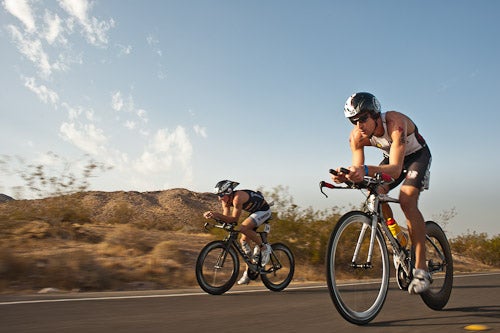Bike Smarter To Run Stronger

Photo: NIls Nilsen
While the finer details of executing the perfect triathlon bike leg are usually specific to the race distance, they generally fall under some broad principles. I’d like to share these with you to help you avoid three common pitfalls, and to set you up for a great run.
Pitfall #1: Treating the bike leg of a triathlon like an all-out bike race
In general, the longer the race, the greater the consequences of imploding on the run. Keep in mind that you’re in a triathlon, not a bike race. The fastest combined time wins—not the fastest bike. For example, a poorly executed Olympic bike can cause you to slow down by 30 seconds per mile for the last 2 to 3 miles of the run, adding about one minute or so to your final time. At the half-iron distance, the consequence can often be 45 to 60 seconds per mile for 3 to 4 miles. For Ironman, it can be up to eight extra minutes per mile for many, many miles as mistakes on the bike reduce you to a walk on the run.
RELATED: How To Pace Your Race
Pitfall #2: Bringing an Ironman nutrition plan to a short-course triathlon
Your body’s ability to process calories decreases at intensity increases. As much of the “how to fuel yourself on race day” conversations revolve around long-course triathlon, many short-course athletes exit T1 with an Ironman nutrition plan. They eat or drink too much, their stomachs rebel and their races are done.
Below are calories-per-hour amounts, by distance, that we’ve found to work for a broad range of athletes. You should experiment to find what works best for you, but we encourage you to start on the low side of these recommendations and work up, if necessary. Why? In our experience, only a couple of quick gels or a half-bottle of sports drink are required to quickly fix a legitimate low-calorie or “bonking” nutritional mess-up. But if you make the mistake of overeating and your stomach shuts down? Game over. That is not a quick fix.
Ironman: 175–300 cals/hr, as a function of body size (bigger eats more). We highly recommend you stick to this range first and go higher only if proven necessary.
Half-Ironman: 100–200 cals/hr, as a function of body size and intensity. Faster folks can begin to redline the 70.3 bike, requiring them to reduce their calorie intake or risk the consequences.
Short course: 0–150 cals/hr, as a function of intensity. In our experience, if you’re going to be racing for less than about 2.5 hours and had a good dinner and breakfast before the race, you have enough gas in the tank for the race without really “needing” to ingest any calories. As you’re out there longer, the requirement to eat does exist, but the key is to not drop into Ironman fueling mode. Simply experiment with our 100-150 cals/hr guidance and see what works for you.
RELATED: Simple Half-Ironman Nutrition Advice
Pitfall #3: Choosing an improper gear combo for your race
Many triathletes are unaware of the best gearing for their specific bike course, showing up with too hard of a gear and wind up wearing out their leg muscles to grind up the hills. Ask an experienced triathlete friend for recommended gearing for your race course, or e-mail us (support@endurancenation.us)—we’re happy to help! Once you have the right gearing, simply search YouTube for videos demonstrating how to change a cassette (it’s so easy!).
RELATED: Understanding Your Bike’s Gears
Rich Strauss is the co-owner of Endurance Nation, a coaching outfit that has trained more than 5,000 athletes since 2007. Endurancenation.us
Follow Triathlete on Twitter @Triathletemag for inspiration, new workout ideas, gear reviews from our editors and more.